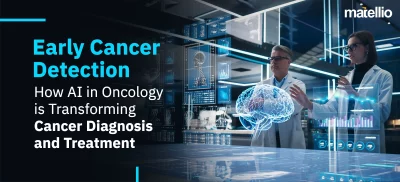
Ever heard of end-of-life software? It’s like when your favorite game gets too old, and you can’t play it on your new console. Now, imagine your business using old, outdated software when everyone else is upgrading to robust enterprise solutions. Clearly, with legacy systems, you will be missing opportunities, whether it be on a revenue basis or on business expansion.
Picture this: your business navigating through a dark forest of problems like computer attacks, slow work, and trouble growing. That’s what end-of-life (EOL) software can bring. But how can you overcome this biggest CIO challenge? Well, we have got you covered!
In this blog post, we’ll break down the tricky stuff, explaining everything about EOL software – the associated challenges, solutions, and examples. So, get ready to ditch the old and embrace the new. We’re here to help you turn problems into victories and make your business a tech superstar!
What is End of Life Software?
‘End-of-Life’ (EOL) in software is a crucial moment when tech companies decide to stop or reduce support for a particular product or version. They shift their attention to newer offerings, leaving the older ones in a kind of software retirement. This happens in a structured process called the product lifecycle, and ‘end-of-life’ is like the last chapter.
During ‘end-of-life,’ the support customers get, like software updates and help with issues and changes. It’s similar to saying goodbye to an old friend. Let us learn from a simple example.
A notable example of end-of-life software is Microsoft Windows 7. After its official end-of-life date in January 2020, Microsoft stopped providing regular security updates and support for Windows 7. This means users still using the outdated operating system are more susceptible to security vulnerabilities and miss out on the latest features and improvements available in newer Windows versions, like Windows 10.
The lesson here is clear: moving to new software that’s safe, fast, and well-supported is the answer. While there might be some expenses and a bit of learning in adopting the latest digital transformation services, the dangers of sticking to old software are much greater than the advantages.
In short, understanding ‘end-of-life’ is crucial in the corporate world, like knowing when it’s time to upgrade your business solution into a next-gen custom enterprise solution.
What is the Risk of Running End of Life Software?
Running a business is not easy, especially during these competitive times. With the advent of digitization, business concerns have only increased, whether it be cybersecurity, data breaches, loss of opportunities due to legacy systems, dynamic customer demands, etc. In such a case, protecting your business from various EOL software risks has become essential. But what are those risks that can impact your business performance? Let’s explore!
 Security Vulnerabilities
Security Vulnerabilities
End-of-Life software exposes your company to heightened cybersecurity risks. Without ongoing updates, it becomes an attractive target for cyber threats, potentially leading to data breaches, intellectual property theft, and compromise of sensitive business information.
Equifax, a major credit reporting agency, faced a massive data breach in 2017 due to unpatched software. The breach exposed the sensitive personal information of over 147 million people, highlighting the severe consequences of security vulnerabilities in End-of-Life software.
 Increased Downtime
Increased Downtime
Using outdated software elevates the risk of system failures and glitches, resulting in increased downtime. This not only disrupts regular business operations but also impacts overall productivity and revenue generation. Opting for modern solutions ensures a smoother operational flow.
British Airways experienced significant downtime in 2017 when an IT glitch, attributed to outdated software, led to the cancellation of over 700 flights. This incident emphasized the potential operational disruptions and revenue loss associated with relying on obsolete systems.
 Compatibility Issues
Compatibility Issues
Outdated software may hinder the company’s ability. Compatibility issues with newer technologies can impede seamless integration, limiting your ability to adopt cutting-edge solutions. Embracing updated software ensures your company stays competitive in a rapidly evolving business landscape.
Microsoft’s discontinuation of support for Windows XP led to compatibility issues for many businesses. The lack of integration with newer technologies hindered their ability to adopt modern solutions and keep pace with industry advancements.
 Regulatory Non-Compliance
Regulatory Non-Compliance
Employing End-of-Life software puts the company at risk of regulatory non-compliance. This could result in legal ramifications, financial penalties, and damage to the company’s reputation. Transitioning to compliant and up-to-date solutions is a proactive approach to safeguarding against such risks.
Uber faced regulatory challenges globally due to its use of Greyball software designed to deceive regulators. This non-compliance with regulations resulted in legal consequences and tarnished the company’s reputation, emphasizing the importance of adhering to regulatory standards.
 Limited Support
Limited Support
The diminishing support for outdated software can pose operational challenges. Your team may encounter difficulties in resolving technical issues, impacting overall efficiency. Investing in solutions with robust vendor support ensures a safety net for your operations, reducing potential disruptions.
The WannaCry ransomware attack in 2017 exploited vulnerabilities in outdated Windows operating systems. Organizations relying on unsupported versions, like the NHS in the UK, faced limited support, exacerbating the impact of the cyberattack.
 Reduced Efficiency
Reduced Efficiency
Outdated software hampers the company’s competitiveness. It lacks the features and capabilities that modern solutions offer, potentially hindering innovation and efficiency. Upgrading ensures your company remains at the forefront of industry advancements, fostering sustained growth and success.
BlackBerry, once a leader in mobile devices, faced reduced efficiency and market share decline due to its reliance on its proprietary operating system. The lack of innovation and app ecosystem compared to competitors impacted its competitiveness in the smartphone market.
 Higher Long-Term Costs
Higher Long-Term Costs
While initial investment in updated solutions is required, sticking with End-of-Life software poses long-term financial risks. Potential security breaches, ongoing system failures, and the need for constant workarounds can accumulate significant costs over time. Embracing modern solutions is a strategic investment in the company’s future stability and success.
The city of Atlanta experienced a ransomware attack in 2018, exploiting vulnerabilities in outdated systems. The subsequent costs for recovery, cybersecurity enhancements, and the overall impact on city services highlighted the long-term financial consequences of neglecting software updates and upgrades.
How to Overcome End-of-Life Software Risks – Top Strategies
Transitioning from end-of-life software requires a strategic and well-executed plan. However, those who are new to the software development field can find this daunting. So, as an expert consultancy, here’s a step-by-step guide to tackling EOL software risks:
 1. Conduct a Comprehensive Software Inventory
1. Conduct a Comprehensive Software Inventory
Conducting a thorough software inventory is like creating a map of your business landscape. To tackle the end-of-life software risks, you need to identify off-the-shelf systems and custom enterprise solutions to get a clear picture of what’s in use. This includes understanding dependencies and how software is intertwined with your business processes. It’s the first step in knowing where to direct your attention.
2. Prioritize Critical Systems
Another tip to tackle EOL software risks is strategy creation. Think of it like safeguarding your kingdom. You should identify and prioritize systems crucial for your business. Locate the enterprise applications that, if compromised, could have a significant impact. Clearly outline your goals for transitioning – whether it’s enhancing security, improving functionality, or aligning with industry standards. You can consider technology consulting services for this step.
3. Evaluate Upgrade Options
Explore the possibilities for upgrading outdated software. Check if newer versions are available or if it makes more sense to transition to alternative solutions that better suit your current business needs. If you have specific processes that are unique to your enterprise, then opting for custom enterprise software development would be the best option.
Why? Well, a trusted custom software development company can help you create a business-specific solution based on your industry concerns, business-specific trends, your choice of features, and even your choice of tech stack. You can even hire developers based on your project’s needs. Matellio offers such perks to their clients.
4. Engage with Software Vendors
It’s like having a conversation with your allies. Reach out to software vendors to understand their support timelines and available options. Some may offer extended support for a fee, providing a temporary solution while plans for migration are developed. You can even talk to data consultants and software experts to opt for digital transformation services wherein your legacy system is updated using the latest tech, APIs, and web modules.
5. Plan and Budget for Migration
Developing a migration plan is akin to preparing for a journey. Allocate budgetary resources for the transition – new software, hardware, and employee training. This ensures a smooth migration process without unexpected roadblocks.
6. Invest in Data Migration and Security
Before making any changes, safeguard your treasures – in this case, your data. Ensure a secure backup of data from existing software to mitigate the risk of data loss during migration. You can consider data migration services from a trusted consultancy for this process, as it can help you create secure backups and strategies to migrate your data from one portal to another without losses.
7. Employee Training and Change Management
Think of it as preparing your army for new tactics. Implement a comprehensive training program to familiarize users with the new software. Address their concerns and provide ongoing support for a seamless transition.
8. Consider Cloud Solutions
Evaluating cloud solutions is like considering a fortress with automatic updates and enhanced security. It reduces the burden on your internal IT teams, allowing them to focus on strategic initiatives rather than managing software versions. Hence, always consider choosing cloud integration services for developing digital solutions or revamping your end-of-life software.
Read More: The Cloud Migration Process: Essentials A Business Should Know
9. Collaborate with IT Professionals/Technology Consultants
Think of technology consultants as your strategic advisors. Work closely with IT professionals and consultants, leveraging both in-house and external expertise. They navigate the complexities of software migration, ensuring a secure and efficient transition. They can even guide you on the best features, the latest yet reliable technology trends, and the next-gen tech integration.
10. Stay Informed About the Latest Digital Transformation Trends
It’s like keeping an eye on the ever-changing landscape. Establish a process to stay informed about the lifecycles of all software in use. Regularly review and update the software inventory to proactively address potential EOL issues before they become critical. You can even consider the latest digital transformation trends to stay ahead in the game and enjoy future-ready business operations.
Read More: Top 8 B2B Digital Transformation Ideas for Enterprises
11. Monitoring and Support
Once you’ve established your new fortress, maintain a vigilant watch. Provide ongoing support and monitor the new system to address any issues promptly. This ensures sustained and optimized operation.
Conclusion
As the tech landscape continues its relentless evolution, navigating the journey of End-of-Life Software transcends a mere necessity; it unfolds as an unprecedented opportunity for robust growth. Embracing change isn’t just a corporate strategy; it’s the cornerstone of unlocking new possibilities and propelling your business into a future defined by innovation.
In this dynamic paradigm, Matellio emerges as your beacon of transformation. As a leading consultancy, we understand the intricacies of EOL software challenges and view them not as roadblocks but as avenues for strategic advancement. Our unwavering commitment to excellence and a proven track record of delivering tailored solutions across diverse domains position us as your trusted ally in this transformative journey.
How Can Matellio Empower Your Business?
Expertise That Transcends Boundaries
Matellio boasts a team of seasoned experts with a wealth of knowledge across AI, ML, mobile apps, and software development services. We don’t just understand technology; we define its contours.
Tailored Solutions for Every Challenge
From overcoming the pitfalls of EOL software to driving comprehensive digital transformations, our solutions are crafted with precision to address your unique business challenges.
Proven Success Across Diverse Domains
Our success stories echo across various industries, demonstrating how we’ve not just met but exceeded expectations in delivering services that catalyze growth.
In partnering with Matellio, you’re not just bridging the gap between challenges and solutions; you’re embarking on a transformative journey where innovation is the destination. Seize the future with Matellio – fill out our form to get a free 30-minute consultation with our experts for your business.
End-of-Life Software – FAQs
Q1. Why does software have an end-of-life?
Software has an end-of-life because technology is always advancing. Just like your old phone gets replaced with a newer, better version, software evolves too. Developers stop updating the old one to focus on creating more advanced and secure versions. It's like saying goodbye to the old so we can welcome the new and improved.
Q2. What are the key challenges in an end-of-life (EOL) process?
In the EOL process, challenges arise because the software no longer gets regular updates and support. This can lead to security risks, system failures, and difficulties in keeping up with new technologies. Managing the transition smoothly becomes crucial to avoid disruptions in business operations and potential security issues.
Q3. How do I manage EOL software?
Managing EOL software involves strategic planning. Identify all software in use, prioritize critical systems, explore upgrade options, engage with software vendors, plan and budget for migration, invest in data migration and security, provide employee training, consider cloud solutions, collaborate with IT professionals, and stay informed about the latest digital transformation trends. Regular monitoring and support ensure a sustained and optimized operation.
Q4. What is the difference between EOS and EOL?
The difference lies in focus. "End of Sale" (EOS) means the vendor stops selling the software, while "End of Life" (EOL) means they stop or limit support. EOS is like taking a product off the market, and EOL is like saying, "We won't update or help much with it anymore." Both indicate it's time to consider newer options.
Q5. How can you help in modernizing our business solutions?
At Matellio, we specialize in modernizing business solutions. Our team of experts, well-versed in AI, ML, mobile apps, and software development, craft tailored solutions for your unique challenges. Whether it's upgrading outdated software, implementing custom enterprise solutions, or exploring the benefits of digital transformation, we guide you through the process, ensuring a seamless transition into the future of technology.
Q6. What is the cost of legacy software modernization services?
The cost varies based on your specific needs. We offer tailored solutions, and the investment depends on factors like the complexity of the project, the features required, and the level of customization. The long-term benefits, including enhanced security, improved efficiency, and staying ahead in the competitive landscape, far outweigh the initial investment. Contact us for a free consultation to discuss your project and get a detailed understanding of the costs involved.
 Security Vulnerabilities
Security Vulnerabilities  Increased Downtime
Increased Downtime  Compatibility Issues
Compatibility Issues  Regulatory Non-Compliance
Regulatory Non-Compliance  Limited Support
Limited Support  Reduced Efficiency
Reduced Efficiency  Higher Long-Term Costs
Higher Long-Term Costs 
 1. Conduct a Comprehensive Software Inventory
1. Conduct a Comprehensive Software Inventory 


